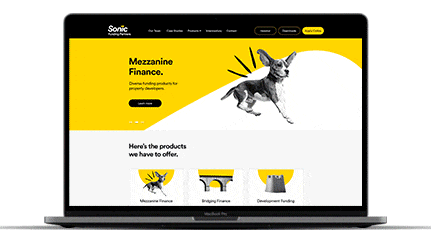The Value of Responsive Website Style in Today's Digital Landscape
In a period where electronic communications are progressively performed throughout a myriad of gadgets, the importance of responsive web site design can not be overstated. A well-optimized website not only improves individual experience but likewise plays an essential function in boosting search engine optimization positions, which are vital for online visibility. As mobile web traffic continues to surge, companies that focus on responsive layout placement themselves to meet customer assumptions efficiently. The effects of this layout strategy extend much past simple looks; the future of online involvement may pivot on how well companies adapt to these advancing requirements. What factors should be considered to make sure long-lasting success?
Enhanced Individual Experience
Enhancing individual experience is a basic goal of receptive web site design. A responsive website adapts seamlessly to different screen dimensions and devices, making sure that users experience regular use despite whether they are accessing the website using a desktop computer, tablet, or mobile phone - Website Design. This versatility is vital in today's digital landscape where customers expect immediate access to information and services
Responsive layout improves navigating by enhancing design and content presentation based upon the tool being utilized. This leads to reduced scrolling, simplified food selections, and properly sized photos, which all contribute to a more instinctive browsing experience. Receptive internet sites load quicker on mobile devices, lessening waiting times that can lead to customer irritation and possible website desertion.
Including receptive layout not just improves contentment but additionally advertises customer interaction and retention. When customers discover web material that is easy to access and browse, they are more likely to suggest the website and return to others. Inevitably, investing in responsive web site design shows a dedication to conference user needs, cultivating a positive partnership between the site and its audience, and enhancing general brand reputation.

Boosted SEO Positions
Among the considerable benefits of responsive site design is its capability to increase SEO rankings. Online search engine prioritize websites that give an optimal individual experience throughout different tools. A receptive design, which adjusts effortlessly to different display sizes, decreases bounce prices and encourages much longer website gos to-- 2 crucial factors that influence internet search engine algorithms.
Google, specifically, has stressed the importance of mobile-friendliness in its ranking requirements. Internet sites that are not optimized for mobile phones might encounter penalties, leading to lower presence in search results page. By applying receptive style, services ensure that their content is appealing and available, despite the device being used. This not only improves user contentment but also signals to internet search engine that the site is appropriate and credible.
Additionally, a solitary URL for both desktop computer and mobile variations streamlines the indexing process for online search engine, as they can easily recognize the website and creep framework. This unified approach removes duplicate content problems, even more enhancing search engine optimization end results. Inevitably, purchasing a receptive web site design is a critical action that sustains greater search engine rankings, driving organic traffic and increasing general online existence.
Boosted Mobile Traffic
The rise in mobile traffic has actually come to be a defining attribute of modern web usage, fundamentally improving how businesses approach their on-line visibility. With an increasing variety of users accessing the internet with smart devices and tablet computers, business must focus on receptive website design to ensure optimum customer experiences across diverse tools.
As mobile traffic remains to climb, companies that fall short to adjust risk pushing away a significant part of their target market. Website Design. A receptive design makes it possible for web sites to immediately adapt to various display dimensions and resolutions, giving seamless navigation and access. This flexibility is vital, as inadequate mobile experiences can bring about high bounce prices and lost conversions
Additionally, the relevance of mobile website traffic is underscored by internet search engine like Google, which focus on mobile-friendly websites in their ranking formulas. This shift stresses the need for businesses to not just boost their mobile interfaces however also to think about individual habits and preferences when producing digital content.
Eventually, welcoming receptive internet site layout not only satisfies the growing mobile audience yet likewise reinforces brand credibility and engagement, positioning businesses for success in an increasingly mobile-centric digital landscape.
Cost-efficient Maintenance
Keeping a receptive internet site style can significantly reduce long-lasting expenses for organizations. By applying a single design that adjusts to numerous gadgets, companies get rid of the demand for several website versions, reducing development and maintenance expenses. This streamlined approach not just conserves sources yet likewise simplifies enhancements and updates.
With a responsive style, services can concentrate on maximizing one site instead than juggling several, ensuring consistency in branding and user experience across all systems. Furthermore, receptive web sites tend to rank much better in online search engine, potentially decreasing the expenses connected with SEO initiatives.
When it concerns updates, a merged system suggests that brand-new functions or material can be turned out without the hassle of readjusting multiple next distinct websites. This effectiveness permits for quicker turnaround times, allowing businesses to react to market adjustments or customer requires rapidly.
Furthermore, as innovation evolves and brand-new devices arise, organizations with receptive styles will face less challenges in adapting their websites. This future-ready approach lessens the probability of incurring unanticipated prices connected with redesigns or platform migrations. By prioritizing receptive layout, companies can accomplish long-term economic sustainability while maintaining an one-upmanship in the electronic landscape.
Future-Proofing Your Website
Preparing for the future of website design is critical for companies Look At This intending to remain relevant in an ever-evolving electronic landscape. As innovation developments, customer expectations change, requiring web sites that not just look attractive but additionally operate effortlessly throughout numerous tools and systems. Future-proofing your internet site entails implementing flexible design principles that fit emerging technologies, such as voice search and fabricated intelligence.
To achieve this, companies must focus on adaptable designs, scalable graphics, and marginal packing times. Welcoming a mobile-first method makes sure ideal efficiency throughout the boosting number of mobile customers. Website Design. Integrating dynamic web applications (PWAs) can improve individual experiences by providing fast, reliable accessibility regardless of network problems.
Consistently updating material management systems and structures is crucial to maintain security and capability. In addition, employing responsive design principles allows websites to change easily to brand-new tools and screen sizes. Organizations must additionally consider accessibility criteria to make sure inclusivity for all users.
Conclusion
In verdict, responsive web site layout plays a critical role in optimizing customer experiences in the modern electronic landscape. Eventually, spending in responsive layout ensures flexibility to future technological improvements, strengthening brand name reputation and cultivating long-lasting on the internet visibility in an ever-evolving digital setting.

Furthermore, as technology develops and brand-new gadgets arise, services with receptive layouts will encounter fewer challenges in adapting their internet sites.In conclusion, responsive site style plays a critical function in enhancing customer experiences in the modern electronic landscape.